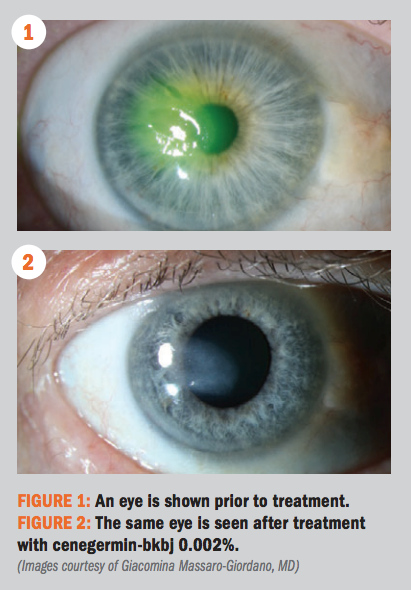Article
Compound eye as treatment for neurotrophic keratitis
Author(s):

Cenegermin-bkbj 0.002% ophthalmic solution, a recombinant form of human nerve growth factor, is the first specific medical therapy for treating neurotrophic keratitis
This article was reviewed by Giacomina Massaro-Giordanao, MD
Cenegermin-bkbj 0.002% ophthalmic solution (Oxervate, Dompé Farmaceutici SpA), a recombinant form of human nerve growth factor, is the first such medicaltherapy to receive FDA approval to treat neurotrophic keratitis, a rare degenerative vision-threatening disease resultingin nerve malfunction and loss of corneal sensation.
This drug is also the first topical biologic medication approved for use in ophthalmology.
The importance of the availability of such a treatment cannot be overemphasized. Before cenegerminwas developed, surgery, artificial tears, or antibiotics may have been the only recourse for these patients, and in many cases there was no real long-term relief.
Cenegermin is a topical drug instilled onto the cornea and as such works to heal damage on the ocular surface. It also can promote tear production.
“The cornea is the first line of ocular defense,” said Giacomina Massaro-Giordano, MD. “Corneal innervation originates from the ophthalmic division of the trigeminal nerve. Nerve growth factor, a naturally occurring neurotrophin, is involved in the differentiation, growth, maintenance of neurons, and corneal integrity.”
Dr. Massaro-Giordano is co-director, Penn Dry Eye and Ocular Surface Center, and professor of Clinical Ophthalmology, Scheie Eye Institute University of Pennsylvania, Philadelphia.
Related: ETM can ease diagnosis burden for screening refractive surgery candidates
Neurotrophic keratitis is classifiedbased on the severity/stage of the disease, and treatment corresponds to the severity. However, diagnosis can be tricky because neurotrophic keratitis can mimic other ocular disorders.
The presence of punctate keratopathy, epithelial irregularity, superficial neovascularization, and stromal scarring characterizestage I disease; a persistent defect of the epitheliumcharacterizes stage II; and stromal involvement with corneal ulceration with possible perforation or stromal melting characterizes stage III. A step-ladder approach is needed to treat neurotrophic keratitis, according to Dr. Massaro-Giordano.
“While treatments are based on disease severity, the treatments are not mutually exclusive of one another, many times a combination of approaches is required,” she said.
Related: Neropathic corneal pain: The new 'umbrella'
Clinical trials
The FDA approval of cenegermin-bkbj was based on the results of two pivotal trials (Europe and United States) in which patients with stage II and stage IIIneurotrophic keratitis were enrolled.
The study’s primary efficacy measure was complete corneal healing,with “complete” defined as 0 millimeter of staining in the lesion area and no persistent staining in therest of the cornea, Dr. Massaro-Giordano recounted.
In these eight-week, randomly selected multicenter studies, the safety and efficacy of cenegermin were assessed in 156 (Europe) 48 (United States) patientswith neurotrophic keratitis.
In one study, patients affected were randomized to cenegermin, an eye drop with a different concentration of cenegermin, or an eye drop without cenegermin. The second study randomized the patients with disease to cenegermin or an eye drop without cenegermin. The designs of both studies required instillation of the drops six times daily in the eye with neurotrophic keratitis for 8 weeks.
Related: Facing challenge of corneal infection management in operated eyes
The results showed that up to 72% of patients achieved complete corneal healing; and 80% of patients who achieved complete corneal healing had no recurrences 48 weeks after treatment, she reported. Dr. Massaro-Giordano was principal investigator of the study at the Scheie Eye Institute.
Eye pain, ocular hyperemia, ocular inflammation and increased lacrimation were the most common adversereactions to cenegermin.
Dr. Massaro-Giordano treated the first patient in the United States with cenegermin drops in December 2018 after it was FDA-approved in August of that year. Since then, in her clinical practice she reported that she has had positive results with the drops.
Thus far, she has treated about 25 people with all three stages of neurotrophickeratitis. Most had stages I and II, and with the exception of one patient, most have improved. She also noted that she uses cenegermin in conjunction withother medications.
Dr. Massaro-Giordano reported the case of a 58-year-old man who had a nonhealing stage II neurotrophiculcer as a result of a brain surgery. The cornea healed after treatment with cenegermin and his corneal lesion has remained closed to date. She said she is encouraged about the potential of the treatment.
“Cenegermin is a novel and needed treatment for neurotrophic keratitis,” she concluded. “Importantly,the mechanism of action of the drug targets the rootpathology of the disease. Future studies are needed to determine other possible indications for this drug.”
Read more by Lynda Charters
Newsletter
Don’t miss out—get Ophthalmology Times updates on the latest clinical advancements and expert interviews, straight to your inbox.





